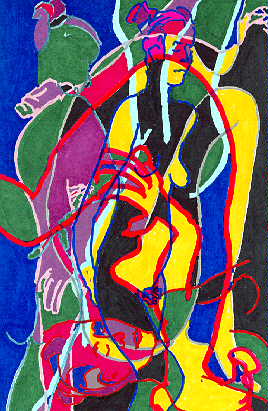
This is one of the first CDs that I appreciated for both style and content. I was particularly taken by the probes section because they opened with fairly strong examples of the concept. The probe section (including Hot & Cool, The Medium is the Message, Violence and Identity, Figure/Ground, Extensions of Man, Tetrads, Acoustic & Visual Space, and The Global Village) also gave a good sense of the McLuhan thought processes which seem to be more artistic than academic. Develop and explain this statement. He seems to ignore scientific proofs and testing of hypothesis. The classification of 'Hot and Cool' media is strongly The classification of 'Hot and Cool' media is strongly exemplified by the mix of animation, sound, and video demonstrating Adolf Hitler. The Figure/Ground probe was also very useful to those working on the e-government project. The dynamic emphasis on the graphical foreground and the background visually reinforced the McLuhan probe of Figure/Ground. 'There is no poverty without affluence'.
Having the texts of book a like "Understanding Media, the Extensions of Man" in digital form will undoubtedly be useful to the researcher. For example, if a researcher wanted to know what McLuhan wrote on 'Africa', he would just search on the word and a pick list would be generated. It was disappointing that a new media intro or summary was not prepared for these textual works.
The video section of the CD-Rom left me with a bad impression. McLuhan presents his thoughts in challenging and disjointed ways. By having a series of video clips spanning several years, strung together on a direct access index the discontinuities are magnified. Thus the provocative is pushed to the ludicrous. A delivery mechanism that contextualized in time, space or thought may have supported McLuhan rather than 'ridiculed'.
The section title 'On McLuhan' did much to give McLuhan the respect he deserves. The people commenting on McLuhan and his work included Derrick de Kerokhove (director of McLuhan Program in Cultural and Technology, University of Toronto), d Technology, University of Toronto), Robert Fulford, Liss Jefferey, Bob Logan, Eric McLuhan, Camille Paglia (professor of Humanities at College of Performing Arts, Philadelphia), Louis Rossetto (Co-founder of Wired Magazine) and Frank Zingrone (professor of Communication at York University). This section contains much anecdotal insight but was lazily crafted with only 'talking head video' or 'video interview transcripts'. I believe more than half of the people interviewed would have gladly constructed something a little more imaginative for their good friend Marshall.
This was an important work for me since it was done in multimedia. So much of my study is in text or film, this gave me a chance to ponder the power of this media.
The sections that worked, like the Probes proved to communicate well to my colleagues in engineering. The weak sections are hard to discuss because they are reasonable media translations of better than adequate work in text or video. To comment well, an alternative such as?should be presented. At this time, I can only say that it feels incomplete.
Page Created March 10, 1998
Page Last Updated April 2, 1998